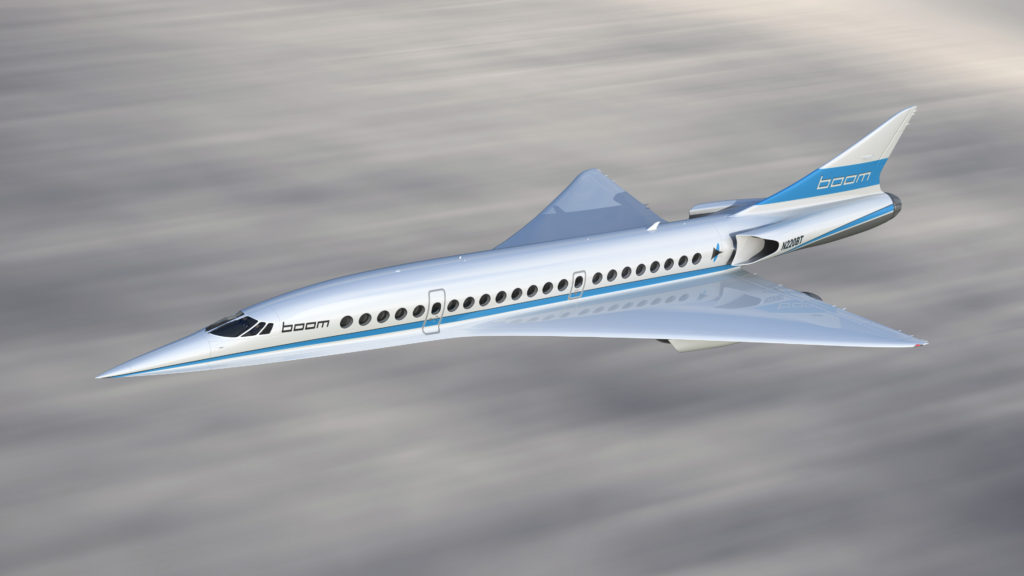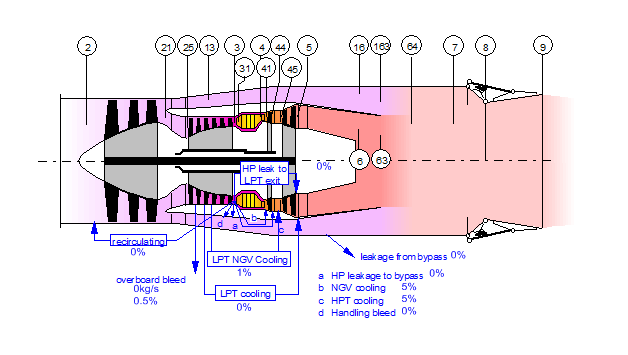Leeham News and Analysis
There's more to real news than a news release.
The Boom SST engine problem, Part 2
By Bjorn Fehrm
Subscription required
Introduction
December 01, 2016, ©. Leeham Co: Boom Technology and Virgin Atlantic plan to offer supersonic business class passenger traffic over the Atlantic. We covered the number of challenges that this poses in recent articles. The most difficult challenge is finding a suitable engine.
We started the investigation into a suitable engine in the last article. A Supersonic Transport Aircraft (SST) needs an engine which is very different from the latest crop of high-performance airliner engines.
The air entering the engine intake at Mach 2.2 is taken from standing still to a speed of 450m/s within a fraction of a meter. This raises the air pressure and temperature more than the combined intake/fan/low compressor does for a modern turbofan. The result is that the core’s high pressure compressor must adapt; it can’t have a high compression ratio (then things get too hot).
Add to that, that the engine must be slender. It can’t have a wide fan and therefore high by-pass ratio because the supersonic drag of such large engines would be too high.
Summary:
- The SST engine must be based on a core with a low pressure ratio.
- Such cores are no longer available in modern airliner engines.
- One must use cores from the military field of supersonic engines.
- We check what kind of engine can be constructed around such a core.
- Is the Boom SST mission then possible with an engine done with an existing core?
Discussion
The core for Boom SST
In the last article, we showed that an engine for an SST must be a combination of nacelle plus engine. And the nacelle must have a sophisticated variable multi-chock inlet system to give the low intake losses required to keep the air’s inherent pressure gain of 10 times when flying at M2.2.
We also needed a sophisticated engine outlet, a variable area convergent-divergent nozzle, so that we can accelerate the air from around 100m/s in the middle of the engine to over 700m/s at engine exit. Otherwise we generate no thrust (we need a substantial exhaust air over-speed over the aircraft’s 650m/s forward speed at M2.2).
The reason commercial cores cannot be used is because they have all high-pressure gains in the core’s compressor section. This raises the temperature of the last compressor stages in an SST application to levels which go beyond their design points. Typical pressure gains for the high pressure compressor for recent engines are 16 (Pratt & Whitney GTF) to 20 (CFM LEAP) or 23 (GEnx-1B).
With a gain of 16 times on top of the intake’s 10 times, we are at an overall pressure ratio of 160 for the intake and core. This creates a total temperature increase of 690°C, which leaves no room for any compression in the engine’s fan section. The engine needs a high-performance fan section, otherwise we have no take-off or climb thrust.
The fan section of the engine must deliver a mass flow and pressure that can be matched with the mass flow and pressure exiting the core. As we must use a convergent-divergent exhaust nozzle, we need to mix the by-pass and core air before the nozzle. For such mixing to be efficient, we need the two streams to have about the same pressure when entering the mixing area at station 64 in Figure 2.
This is achieved by keeping the fan pressure gain at around 3.5-4. This leaves a desirable pressure gain in the high compressor of around 6-7, something that one only find in military cores.
The EJ200 core
The EJ200 core for the Eurofighter Typhoon has a core with a 5-stage high compressor with a pressure gain of 6 and a pressure capability of 3,000kPa/435PSI.
Its three-stage fan has a pressure ratio of 4.5. Its diameter of 0.85m gives a total airflow of 77kg/s, whereof 46kg/s is needed by the core. This leaves 31kg/s for the by-pass which creates a By-Pass Ratio (BPR) of 0.4. All values are from the Top of Climb (ToC) which is the most aerodynamically demanding mission point.
The fan and high pressure compressor are driven by a single turbine each. The high-pressure turbine has a maximum entry temperature (T41) of 1900K. This is for a take-off situation which has a short duration (five minutes maximum for a civil certification). For the demanding climb and cruise for an SST engine, we will assume a max T41 of 1,800K.
Total static take-off thrust for the EJ200 without afterburner on an ISA day (+15°C) is 60kN/13,500lbf. This is a bit short of our needs. We might be OK for the take-off situation on an ISA day but not for hot days out of many airports.
As Boom says they are ready to invest in a new low pressure system, we will keep the core airflow at 46kg/s and increase the bypass airflow to at least equal (BPR 1.0), or up to double the core airflow (BPR 2.0). This will require splitting the turbine for the larger fan stage over two low pressure turbine stages.
With BPR 1.0, we reach around 70kN/15.7klbf and with BPR 2.0 around 84kN/18.9klbf take-off thrust. Both values will be limited by the T41 temperature which decides the turbine section’s capability to deliver shaft hp to the fan section.
F414 alternative core
The GE Aviation F414 military turbofan is very similar to the EJ200. The difference is that it was conceived for an aircraft, the Boeing F18 Super Horrnet, that fly maximum M1.7. The overall pressure ratio at Top of Climb is therefore higher at 30:1.
It has the same three stage fan section as the EJ200 but a seven stage high pressure compressor. GE has not publicized the pressure ratio for the high compressor but one can assume it would be in the region 7-8 and therefore a bit on the high side for our purposes.
Boom SST mission profile
The critical thrust area for the engine will not be the take-off. It will be the climb to an optimal cruise altitude of 57.000ft for a M2.2 SST. An aircraft like Boom SST needs such high cruise altitudes, otherwise the dense air will create too much skin friction drag. This will cut the range too short for trans-Atlantic crossing and heat the skin over what the structure can handle.
The climb will be the most challenging flight phase for the SST’s nacelle/engine combination. The excess thrust over drag will be small, as the Boom SST will avoid an engine with afterburner. This will require a special climb technique like the one employed by the Concorde.
Concorde climbed sub-sonically to around 30,000 ft, where it accelerated to supersonic speed in level flight. When the aircraft became supersonic the engine thrust increased (as the intakes secured pressure recovery) and the aircraft did a gradual cruise climb to 57,000 ft. The Concorde used the engine’s afterburner to combat the drag increase when passing the sound barrier and for the supersonic climb.
The Boom SST will manage this without an afterburner. We will go in detail of the drag of the aircraft and compare it to the thrust from the engines during climb and cruise in the next article.
This will reveal what margins there are for a concept like the Boom SST, using a low by-pass turbofan to do the job where the Concorde used a straight jet with afterburner.




Hello Bjorn,
What is the overhaul interval of such military engines?
BOOM SST will have to fly 8-9h a day ? so; 3000 h /year
Can’t go for an overhaul per year? can you?
Furthermore, the fighters spending most of their time flying subsonic aren’t seeing max OPR for long ? are they ?
We are speaking abour 2h + at mach2 !
Interesting challenge
Hi Crise,
you are right. The EJ200 has a very good reliability in the Typhoon mission (1000h between overhauls) but still this is an area that we will discuss. We will see in the next article at what stress level the engine has to work. It is steady state stress versus the transient rich stress of a fighter engine, which includes afterburner use which is generating high loads. It might be the engine cycle has to be adapted because too high stress levels. Or the core is to small.
Once we have all the temp and pressure data for the SST mission we will look at the other things that a Boom project has to accomplish, beyond a functional engine flying a functional mission.